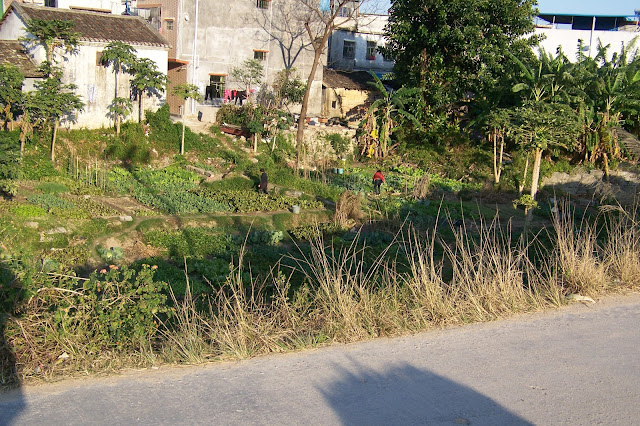We did not spend a lot of time in the villages. We were in Edward's mother's village once for about 90 minutes and in Edward's father's village twice, on consecutive days, for a total of three hours or so.
I took a lot more pictures than I have been able to use in the stories I have told so far.
 These pictures of brooms, for example, have not found a place in a story -- yet I find myself drawn to them as meaningful objects. These brooms are made of a kind of dried weed or straw tied to a bamboo pole or stick. There is nothing unusual about these brooms apart from the fact that they are handmade of regional materials and, thus, they look interesting.
These pictures of brooms, for example, have not found a place in a story -- yet I find myself drawn to them as meaningful objects. These brooms are made of a kind of dried weed or straw tied to a bamboo pole or stick. There is nothing unusual about these brooms apart from the fact that they are handmade of regional materials and, thus, they look interesting.As odd as this may sound, I think that the brooms people use indicate something about them. Certainly these brooms tell us about culture and history, but perhaps they indicate an attitude about the present as well. To illustrate, in all my six plus decades, I have never seen anyone use a handmade broom in America; yet I have seen handmade brooms in all the foreign countries I have visited. I am not sure what this indicates about us as Americans apart from our preference for the neat, progressive look of factory brooms.
But both in Russia and in Korea I saw brooms without shafts in common use. Imagine straw brooms, like the ones pictured, without handles. Short brooms of that sort require the sweeper to bend over, sometimes nearly double. In Russia these short brooms seem to be made of bundles of sticks, although I may be wrong in that observation. I first saw them in use by soldiers sweeping at the front gate of a military post, so they are not just the choice of the old women who appear everywhere sweeping streets and hallways. Many of these old women seemed to be bent double from the hardships of life.
These two gardens are in Lehu, the neighboring town of 380,000. Local residents have created neat gardens that fit and utilize small or odd shaped areas that would otherwise lie vacant and gradually fill with trash. In both of these cases, the areas are designated for building projects; but in the meantime, enterprising folks are raising vegetables.
To shift my focus a bit, disposing of trash, like pollution generally, has been an urgent problem of rapid modernization in China during the last thirty years. Among the pictures I did not take (for a variety of reasons) was a picture of the stream that ran through LuoXi village. It lies below the iron pipe railing on the left-hand side of this picture.
What struck us about this little stream was that it was filled with plastic bags of the grocery store variety. Many of these bags in the countryside are red, so they stand out. The widespread use of thin plastic bags is a recent phenomenon in China, as it is, interestingly, in England too. These bags are cheap, useful, and sturdy to a point; but their wide use has created a litter problem previously unseen. Villagers, until recently, would have used bags or baskets made of natural fibers that could be repaired or that would disintegrate over time, so the habits of disposal that have worked for milenia now create problems.
A third kind of photograph I like to take involves brickwork, stonework, tiles, roof lines, wall construction, earthen buildings.
Whatever else this building may tell us, its construction is an odd mix of masonry. Part of the building was built of stones such as one would pick up from the river bed or even from the fields. Walls lining fields in New England are famously made of stones removed from cleared land in order to facilitate cultivation of fields. Sometimes, too, foundations of old New England homes may be made of these same stones; these are called rubble foundations. Well-made, they can be sturdy; but inexpertly made, they tend to fall apart. On this building, the stone-work is augmented by or repaired with two kinds of bricks. The older of these are the larger, tan bricks. These don't separate from one another and crumble into a heap like stones, but they do tend to break apart more easily than the newer, smaller, modern "red" bricks, which are the newest part of this building.
When I walked down to this little building to take pictures of the walls and the tiled roof, thinking the sunlight might create some interesting textures and patterns, my interest seemed to create a stir.
As I got to the door, after shooting any number of wall pictures, Edward hustled over. "Pop," he said, "don't go in there."
I backed away, thinking I had approached something forbidden, hidden, secret, mysterious.
"They are afraid you might go inside," Edward said. "It's an outhouse."
I shot a lot of interiors, but not of that building. That was another picture I decided not to take.







No comments:
Post a Comment